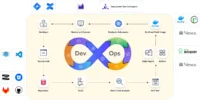Welcome to the dynamic realm of DevOps, where continuous integration, continuous delivery, and collaboration reign supreme. However, even in this well-orchestrated symphony of code and deployment, bugs and issues can emerge. Fear not, as this article is your guide to effective DevOps debugging – helping you troubleshoot with agility and precision.
The DevOps Orchestra: Recognizing the Symphony of Troubles
In the DevOps orchestra, identifying the nuances of potential issues is the first step. Pay attention to the melody of error messages, unexpected behaviors, and performance hiccups. By recognizing the symphony of troubles, you lay the groundwork for effective debugging.
Real-time Monitoring: Tuning into Performance Metrics
Tune into real-time monitoring to gather performance metrics. Utilize monitoring tools to keep an eye on resource usage, response times, and system health. Real-time insights empower you to pinpoint anomalies and understand the heartbeat of your applications.
Comprehensive Logging: Tracing the Footprints
Traverse the code maze with comprehensive logging. Implement detailed logging throughout your applications to trace the footprints of execution. Log relevant information, errors, and warnings to aid in reconstructing the journey of the code and identifying potential pitfalls.
Code Reviews: Collaborative Inspection
Embark on collaborative inspection through code reviews. Engage your development team in systematic code reviews to identify potential issues early in the development process. Fresh pairs of eyes can catch subtle bugs or offer alternative perspectives on troubleshooting.
Version Control: Rolling Back the Melody ⏪
When facing unexpected issues, consider rolling back the melody using version control. Git and other version control systems enable you to revert to a known stable state. This approach provides a quick way to eliminate recent changes as potential sources of trouble.
Automated Testing: Harmonizing Quality Assurance
Harmonize quality assurance with automated testing. Invest in a robust suite of automated tests to catch bugs before they reach production. Unit tests, integration tests, and end-to-end tests collectively contribute to the symphony of reliability in your DevOps practices.
Container Orchestration: Balancing the Ensemble
Balance the ensemble with container orchestration. Platforms like Kubernetes ensure consistent deployment and management of containerized applications. Container orchestration not only streamlines deployment but also aids in troubleshooting by providing a unified environment.
Collaborative Debugging Sessions: Ensemble Troubleshooting
Ensemble troubleshooting comes to life through collaborative debugging sessions. Bring together developers, operations, and other stakeholders to collectively analyze issues. A collaborative approach fosters knowledge-sharing and accelerates the identification of root causes.
Continuous Integration Pipelines: Orchestrating Flawless Performances
Orchestrate flawless performances with continuous integration pipelines. Implement CI/CD pipelines that automate the build, test, and deployment processes. Automated pipelines not only enhance efficiency but also contribute to early bug detection and resolution.
Post-Incident Analysis: Learning from the Symphony
Learn from the symphony through post-incident analysis. After resolving issues, conduct a thorough analysis to understand the root causes and prevent future occurrences. This continuous learning cycle strengthens your DevOps practices and fine-tunes the harmony of your development and operations teams.
Conclusion: Conquering the Code Symphony with DevOps Debugging
In the intricate world of DevOps, effective troubleshooting is the key to conquering the code symphony. By recognizing the symphony of troubles, tuning into real-time monitoring, tracing the footprints with comprehensive logging, engaging in collaborative code reviews, utilizing version control, harmonizing quality assurance with automated testing, balancing the ensemble with container orchestration, conducting collaborative debugging sessions, orchestrating flawless performances with CI/CD pipelines, and learning from the symphony through post-incident analysis, you’re not just debugging – you’re conducting a harmonious symphony of reliable, scalable, and resilient DevOps practices. May your code always play in tune, and may your DevOps journey be filled with continuous improvement and flawless performances!








